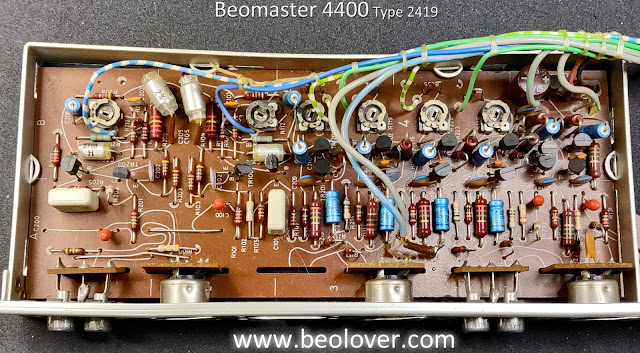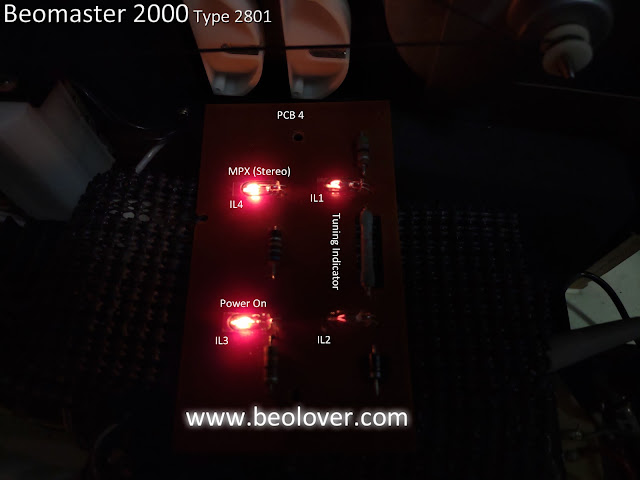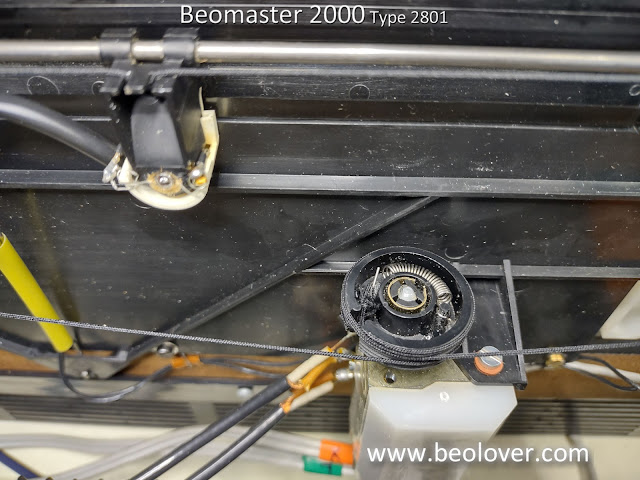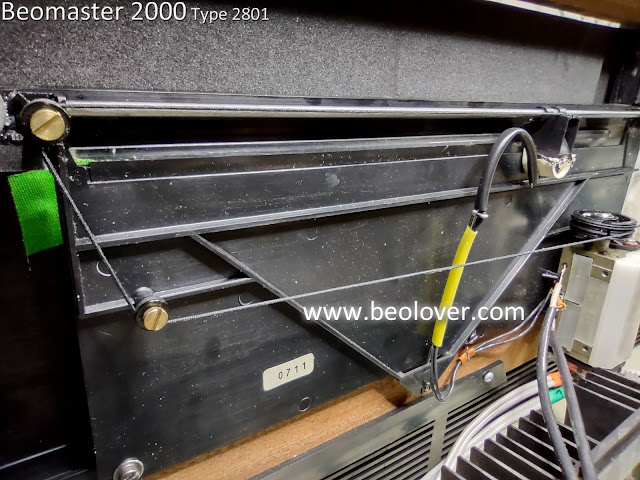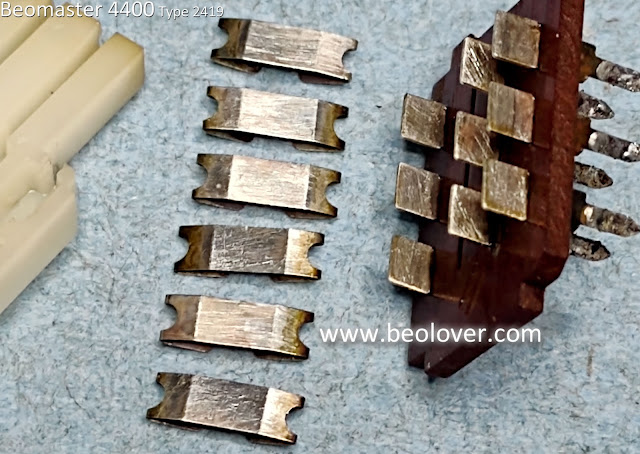A while ago I received a Beogram 4000 from Germany
for restoration before sending it on to a customer in California. This post shows my initial assessment.
Under the aluminum panels this unit was fairly original, except the messy partial replacement of the reservoir and motor capacitors done previously:
As usual, I started out by focusing on the carriage. This shows the arm lowering mechanism:
It is a good idea to remove the moving components and clean them of hardened old lubricants in an ultrasonic bath before putting the mechanism back together:
While the carriage is up, it is a good moment for restoring the three solenoid activated switches, which usually have bent terminals from earlier attempts to alleviate operational issues. This Beogram was a good example for this rule:
I removed the three switches to extract the terminals:
This shows the 'nicely' oxidized removed terminals:
I also removed the switch terminals from the PCB that determines the carriage position and gold plated all of them:
Beogolden! Then it was time to reassemble the switches. This shows the solenoid switches
and this the carriage position switches. On this board I also replaced the as usual browned solenoid current limiting resistor with a modern unit of double Wattage:
While all this was apart, I also had a look at the now easily accessible solenoid power transistor, which often is out of spec. This one immediately gave up when I touched its terminals. One leg came off right away:
I replaced it with a new TIP41:
Then I re-installed the solenoid switches:
The final touches on the carriage were to install a new aluminum carriage pulley to replace the original cracked plastic unit,
installing a LED based light source in the tracking sensor,
and removing the sensor arm to extract the damper-to-arm linkage for cleaning and lubricating its pivot point, which is a frequent source of arm lowering trouble in these decks:
As usual, the small copper plate that reduces the friction between the arm lowering limit set-screw and the sensor arm fixture was about to come loose. I removed it and cleaned off the double sided tape residues
and epoxied it back to the fixture:
My next focus was the keypad cluster, which contains the 'brain' of the Beogram 4000, which is composed of a number of hardwired logic gates enabling complex decision making during the operation of the deck:
As usual the keypad switch terminals were black from oxidization:
I extracted the terminals
and gold plated them:
Then I re-installed them:
I also updated the carriage position scale illumination and RPM trimmer back lights with LED based assemblies:
A slight tuck at the strobe mirror dislocated it from the keypad assembly. I have come to expect this in Beogram 4000s:
I cleaned it and epoxied it back into place:
With the keypad cluster removed it was the perfect moment for installing a switch that allows connecting signal and system grounds in case humming issues come up. This often happens when RCA adapters are used and connecting the grounds together usually seems to take care of any hum issues:
The AC platter motor/main capacitor section was next on my list. Unfortunately, this Beogram had already seen some 'attention' and some of the capacitors had been replaced with new units:
Due to the smaller form factor of newer components this was carried out by glueing the capacitors to the enclosure of the Beogram, leaving these ugly remnants behind after removing the caps:
Luckily a 2-day soak in isopropyl alcohol softened the glue enough that I was finally able to remove it with a bit of detail work and patience:
While this soak happened I had taken apart the AC motor for an oil infusion under vacuum:
With all the components removed it was easy to get to the 24V Zener diode that regulates the 24V rail:
This Zener is a bit under-dimensioned and therefore gets pretty warm, resulting in a voltage drift of the rail to voltages in the 26V range. I now always replace this diode with a modern 5W type, which is able to keep the voltage close to 24V:
Then it was time to install the new capacitors, held in place by a 3D printed custom fixture, and the re-lubricated AC motor:
The next step was restoring the PCBs. This shows the power supply board with the yellow reed switches, that control the power rails:
The yellow components are the coils that each activate two glass enclosed reed switches. The top relay controls the 220V line (note the black insulation) for the strobe light and the AC motor oscillator, while the lower relay is responsible for the main 24V and 6V rails:

Unfortunately, this Beogram had a dead 6V switch, which caused it to be unresponsive to keypad events (the control logic runs on the 6V rail). It is not entirely trivial to replace these reed switches since they are pulled down in series from the 24V supply, i.e. they are 12V relays, and so both need to have the same resistance for receiving the proper voltage. In addition, the top relay that controls the platter motor oscillator is also hooked up directly to the 33 RPM switch, which is able to turn on the platter motor when the deck is off for swiping the record. All this taken together left two choices: 1) replace both relays with identical modern 12V units or 2) just replace the broken one with a modern 24V relay in parallel to the two 12V original relays and leave the broken second relay in place to keep the voltage divider intact for the upper relay. I did not like 1) since it would have required to find a safe solution for the 220V strobe circuit, and so I settled for 2). I glued a small 24V relay on top of the broken reed relay and bridged its switches with the new relay switches:

This allowed to keep the top relay with its platter sweeping circuit in place, while restore the 6V rail switch.
This shows the main PCB in its original condition:
I replaced all electrolytic capacitors, replaced the RPM relay and RPM trimmers and installed new transistors in the solenoid circuit:
I also replaced the high-gain transistor that amplifies the record detection sensor signal with a modern type (the original ones tend to go out of spec, loosing their gain) biased with a 25 turn 5MOhm trimmer which allows precise adjustment of its working point:
This shows the completely restored board:
While the board was up I also replaced the AC motor power transistors in the push-pull stage, but forgot to take a picture.
After restoring the sensor arm circuit I replaced the light bulb in the arm with a LED assembly. This one is a new prototype design, which does away with the previous flexible PCB approach. Too many DIY customers had issues with its implementation and so I decided to replace it with a very small hard PCB that is easier to install:
This shows it in place...
...and in action:
This is the measurement of the sensor response, fully meeting the 2.2V spec prescribed in the manual:
It is a good idea to replace the MMC cartridge mount of Beogram 4000s since the plastic has become brittle over the years, and even while they often look pristine, they can very easily break off when cartridges are mounted or removed. Frequently, this results in cartridges that need to be serviced when the broken off tab cannot be removed anymore from the cartridge.
Luckily it is possible to replace these brittle mounts. The first step is the removal of the tone arm and cook its 'business-end' for an hour:
This loosens the glue and the mount can be pushed out with a properly sized rod. Then the 3D printed (nylon material) replacement part can be installed. This shows the installed replacement:
Like most Beogram 4000s this one had cracked plinth guidance washers:
I replaced them with 3D printed washers. The one for the front-center position needs to be black. Otherwise it can be seen between the aluminum panel and the wood plinth:
This shows one of them installed:
This Beogram came with a strange fixture installed, possibly the pivot point from a wet-play system that were popular in the 70s:
The glue proved to be very tough to crack. I had to heat the plate to about 300F for a couple hours until I was finally able to remove the item. Some glue remained in place, however:
I soaked the area in isopropyl alcohol for a day:
This finally allowed me to clean the glue remnants off with a Mr. Clean eraser pad (only use the original blue type - the harder red type is too harsh).
At this point only adjustments and calibrations still separated me from giving this deck a first spin. I did all the platter and sub-chassis alignments and after everything was in spec, I adjusted the arm lowering limit
and calibrated the tracking weight:
Then I did a 24hrs RPM stability test with the BeoloverRPM device:
It allows logging the RPM in 10s intervals for extended periods of time. This is the predictably boring curve that I measured on the AC motor Beogram:
The AC motors are usually very stable. The benefits of synchronous motors! No feedback issues etc...the only variations come from temperature (and possibly moon phase...;-) effects.
Before finally putting a record on this deck I replaced the corroded original DIN plug with a new gold plated all metal plug:
And then the rewarding moment had arrived! My current Eberhard Weber phase made me celebrate this restoration with his
1985 album 'Chorus' on ECM (ECM 1288). A perfect meditative sound track for restoring Beogram 4000s! Of course this album was ultrasonically cleaned with a
CleanerVinyl Pro System. Beolovely! Kraut jazz played on a beautiful Danish Beogram. Euroheaven!...;-)
I will now play this Beogram 4000 a bit longer to make sure there are no intermittent issues, and then it will be time for it to move on to California!




